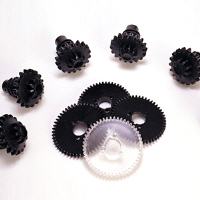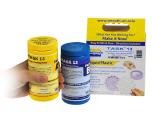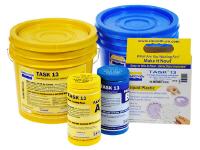TASK 13
High impact resistance, low cost semi-rigid plastics for durable miniatures, black-colored props, etc...
Task 13 products
Task 13&14
Technical bulletin Task 13 & 14
TASK® 13and TASK® 14 are fast setting two-component urethanes that cure quickly to black semi-rigid plastics. TASK® 13 has a pot life of 3 minutes and demold time of 20 minutes. TASK® 14 offers a longer pot life (10 minutes) and demold time of 45 minutes. With a Shore value of 50D, these semi-rigid plastics are used for a variety of industrial applications including fast mold making, fast model duplication, prototyping, durable miniatures, black props and special effects, or making parts that are impact resistant. Fully cured castings are tough, durable and chemical resistant.
Instructions
Materials should be stored and used in a warm environment (73°F/23°C). These products have a limited shelf life and should be used as soon as possible. All liquid urethanes are moisture sensitive and will absorb atmospheric moisture. Mixing tools and containers should be clean and made of metal, glass or plastic. Mixing should be done in a well-ventilated area. Wear safety glasses, long sleeves and rubber gloves to minimize contamination risk.
For Best Results… Do not cast TASK™ 13 into platinum cure (addition cure) silicone molds.
Because no two applications are quite the same, a small test application to determine suitability is recommended if performance of this material is in question.
Applying A Release Agent - If you are unsure about surface compatibility, a trial casting on a surface finish similar to the final mold or model should be made to avoid damage to the working surface. Polyurethane, latex or metal molds should be dry and require a coat of suitable release agent. Universal Mold Release™ (available from Smooth-On) is ideal for this purpose. A liberal coat of release agent should be applied onto all surfaces that will contact the plastic. To ensure thorough coverage, lightly brush the release agent with a soft brush over all surfaces. Follow with a light mist coating and let the release agent dry for 30 minutes.
Before Measuring & Mixing - Part B (blue label) must be stirred well before use.
Measuring - The proper mixing ratio is 100 Parts A to 120 Parts B by weight. You must use an accurate scale (gram scale or triple beam balance scale) to weigh these components properly. Dispense the required amount of Part A into a mixing container. Weigh out the appropriate amount of Part B and combine with Part A.
Mixing - Materials should be stored and used in a warm environment (73° F / 23° C). Shake or stir Part A & Part B before using. Add Part A to Part B and mix thoroughly. Stir slowly and deliberately making sure that you scrape the sides and bottom of the mixing container several times. Be careful not to splash low viscosity material out of container. Remember, product sets up quickly. The higher the mass concentration, the faster the material gels and cures. Do not delay between mixing and pouring.
IMPORTANT: Shelf life of product is reduced after opening. Remaining product should be used as soon as possible. Immediately replacing the lids on both containers after dispensing product will help prolong the shelf life of the unused product. XTEND-IT™ Dry Gas Blanket (available from Smooth-On) will significantly prolong the shelf life of unused liquid urethane products.
Pouring - Pour mixture in a single spot at the lowest point of the mold. If encapsulating an object, do not pour the mixture directly over the object. Let the mixture seek its level. A uniform flow will help minimize entrapped air.
For Best Results . . . Best results are obtained using a pressure casting technique. After pouring the mixed compound, the entire casting assembly (mold, dam structure, etc.) is placed in a pressure chamber and subjected to 60 PSI (4.2 kg/cm2) air pressure for the full cure time of the material.
Curing - Important: Use this product with at least room size ventilation or in proximity to a forced outlet air vent and do not inhale/breath fumes. Fumes, which may be visible with a significant mass concentration, will quickly dissipate with adequate ventilation. Castings with significant mass may be hot to the touch and irritate skin immediately following cure. Let casting cool to room temperature before handling.
Demold time of the finished casting depends on mass and mold configuration. Low mass or thin-walled castings will take longer to cure than castings with higher mass concentration.
If making rotational or hollow castings, backfilling with a rigid foam (Foam-iT!™ 5 or other) will provide lightweight reinforcement. Foam backfilling is recommended if castings will be subjected to temperatures above 85°F / 30°C.
Performance - Cured castings of TASK™ 13 are semirigid, durable and exhibit negligible shrinkage. They also resist moisture, moderate heat, solvents and dilute acids. Mold release must be removed prior to painting or bonding the cured piece.


